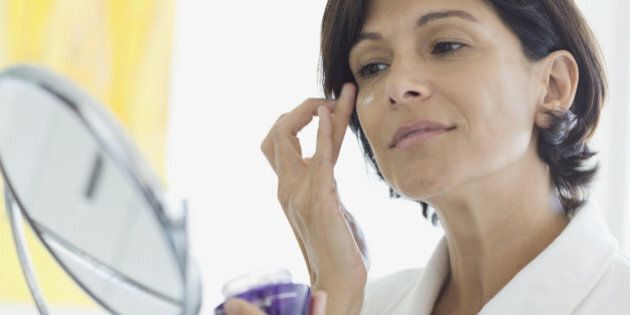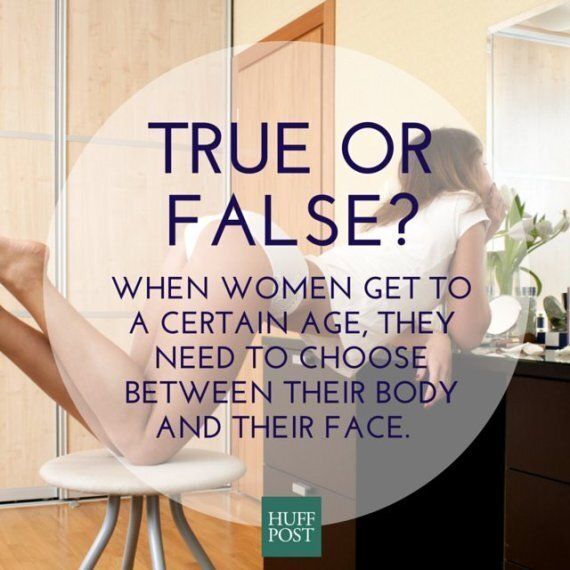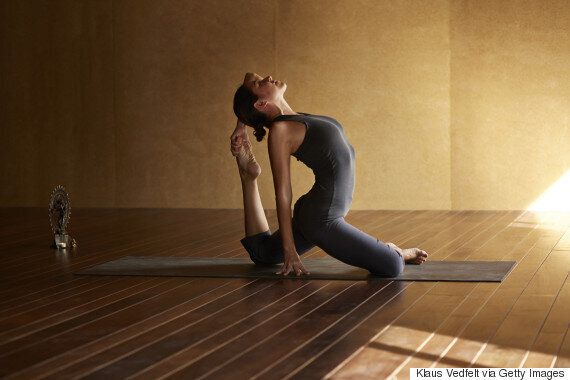

What do Mae West, Catherine Deneuve, Courteney Cox and Jane Fonda all have in common?
Each actress has, at one stage, referred to the choice women must make at a certain time of their life -- and that is between their face and their body. (Well, actually, between the face and the arse, but you know what we mean.)
The argument being that apparently the face looks better 'filled out' while the body looks better lean, but as women age, it becomes harder to achieve both simultaneously. Hence the ultimate Sophie's choice (and yes, we are absolutely kidding).
But is there actually any truth behind this old saying? Is it really either/or?
According to Dr Jeremy Cumpston of Ageless Clinics, the answer is... kind of.
"The problem with that whole notion is flawed in the assessment of why we age," Cumpston told The Huffington Post Australia. "Essentially there are two issues happening, the first being volume loss in the face.
"This is usually caused by the loss of the proteins collagen and elastin, which are water carrying molecules, and the loss of natural sugars within and around the cells.
"Basically, the main difference between a young face and an old face is volume.
"At ages 16-18, you have your full amount of collagen, elastin and sugars, which is why an 18 year old's face looks like it’s actually glowing. It’s because the light is entering tissue, defusing and reflecting through all the water in the tissue, then bouncing out and returning to the skin. It looks like it's glowing, like it's full and fresh.
"Basically, if you imagine trying to bend a full pillow, you'd find it really hard to create a wrinkle. That's young skin.
"If you take a piece of paper and bend it, however, it's easy. That's the difference."
According to Cumpson, Australians have it even harder than most, with the problem of our ozone layer (or lack thereof) further contributing to skin damage and the appearance of aging.
"In Australia, we have 10 to 100 times the UV exposure than our Northern European counterparts. Who were the ones who caused it by the way," Cumpson said.
"Not only do we then have 100 to 200 times the chance of contracting skin cancer, but the skin thickness of women aged 40-plus in Northern Europe as opposed to Australia is anywhere from a third to a quarter thicker.
"The thing in Australia is, if you want to look after your face, you need to use the maximum sunblock and you need it three times a day."

This lady does not work in a cave, so she will need to slip slop slap daily.
For those who claim they don't need such an extreme approach to sunscreen because they spend most of their days indoors -- nice try, but no cigar.
"I hear that all the time, people saying it's okay because they work in an office," Cumpson said. "To that I say, 'Is there no sunlight in your office? Do you work in a cave? Do you catch public transport to work? Do you go outside for lunch?'
"If you don’t want to lose your face, then for God's sake don’t lose your collagen and elastin and use sunblock."
Cumpson also states most Australian adults have a vitamin A deficiency which, in turn, is doing no favours for the skin.
"In order to make collagen and elastin, you need a vitamin called Vitamin A, also known as retinol," he told HuffPost Australia.
"Of course, what destroys retinol in the skin? UV. Meaning practically every Australian women, man and grown child is vitamin A deficient. You can tell that by the brown spots or age spots you get when you're older.
"I liken vitamin A to the engine and petrol of the engine of collagen and elastin production. So losing it, and not replacing it, is like a bath that once was full but keeps on draining and you're not filling it up again."
The second issue contributing to the aging process is the popularity of punishing exercise regimes which can take too much of a toll on the body.

Want tight buns? Get your yogi on.
"There are 21 fat pads in the face and if you exercise regularly like a maniac, like lots of women who want to keep in shape, this increases the formation of free radicals which oxidises or ages the skin, and also increases the loss of fat pads around their face which makes them look completely haggard," Cumpson said.
"Which is why, if you are a younger woman -- say you are 30 and slim -- you will look younger than someone who is 30 and carrying 10 extra kilos. But take that same situation for a 40 or 45-year-old, and the person carrying the extra kilos will actually look younger."
Cumpson points out it doesn't have to be that way, and that all forms of exercise doesn't have an aging effect.
"You have to protect the collagen and elastin, and so you want to choose an exercise that is not rapidly producing those free radicals," he said.
"Do not run in the sun. That is very important. It's great for weight loss but nothing else.
"The best thing you can possibly do is yoga. Everyone knows it. Practice yoga and eat really healthy balanced meals as well as making sure you stay super hydrated.
"You want to not strip out your fat stores so much by doing a harsh and punishing exercise. Yoga is still strenuous, it still builds muscle tissue and improves the body shape. But it means your face won't look as haggard as if you were doing a high cardiovascular sport usually done in high UV exposure."
So in conclusion? You don't need to choose between your body or your face as the aging process marches on, but according to Cumpson, you do need to make certain choices to ensure you are looking after them both.
"If you really want to choose both, it is quite didactic," Cumpson said. "It's possible, but you have to be very, very careful from age 20 onward."